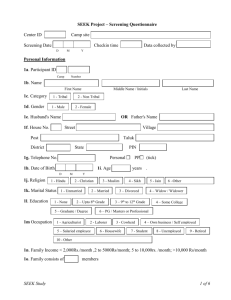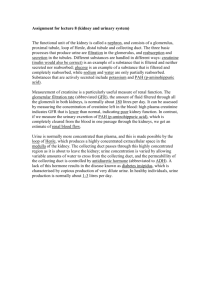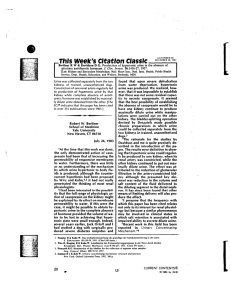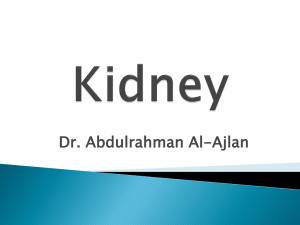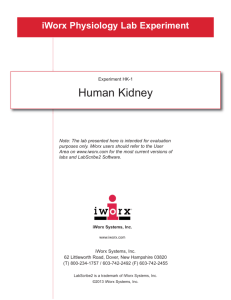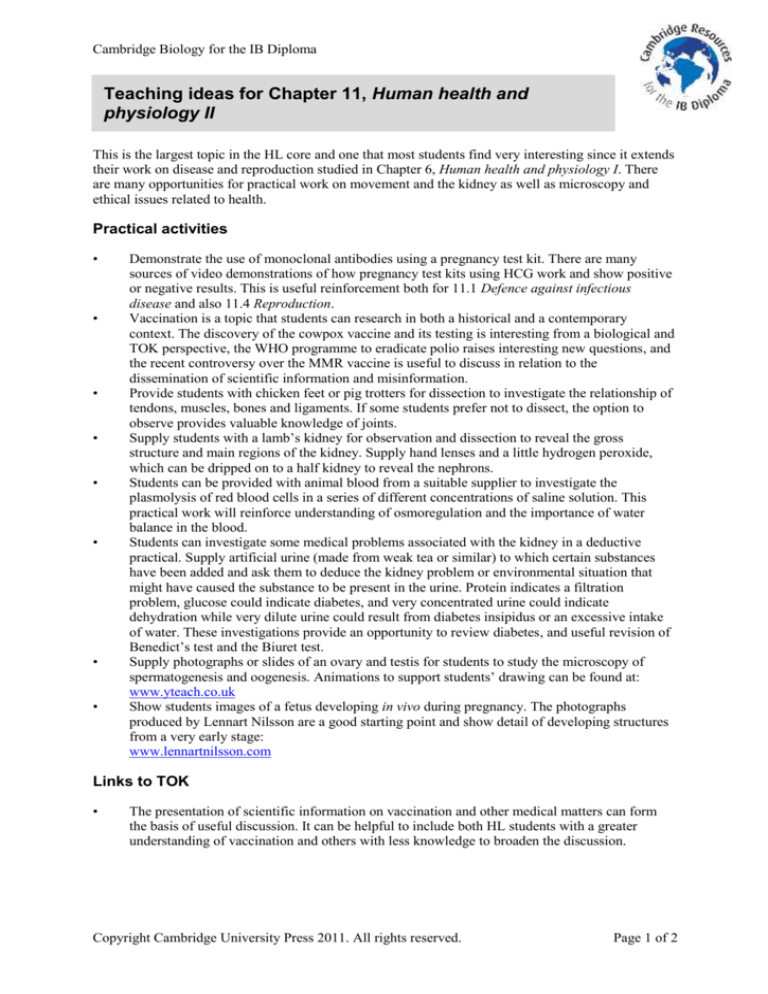
Cambridge Biology for the IB Diploma
Teaching ideas for Chapter 11, Human health and
physiology II
This is the largest topic in the HL core and one that most students find very interesting since it extends
their work on disease and reproduction studied in Chapter 6, Human health and physiology I. There
are many opportunities for practical work on movement and the kidney as well as microscopy and
ethical issues related to health.
Practical activities
•
•
•
•
•
•
•
•
Demonstrate the use of monoclonal antibodies using a pregnancy test kit. There are many
sources of video demonstrations of how pregnancy test kits using HCG work and show positive
or negative results. This is useful reinforcement both for 11.1 Defence against infectious
disease and also 11.4 Reproduction.
Vaccination is a topic that students can research in both a historical and a contemporary
context. The discovery of the cowpox vaccine and its testing is interesting from a biological and
TOK perspective, the WHO programme to eradicate polio raises interesting new questions, and
the recent controversy over the MMR vaccine is useful to discuss in relation to the
dissemination of scientific information and misinformation.
Provide students with chicken feet or pig trotters for dissection to investigate the relationship of
tendons, muscles, bones and ligaments. If some students prefer not to dissect, the option to
observe provides valuable knowledge of joints.
Supply students with a lamb’s kidney for observation and dissection to reveal the gross
structure and main regions of the kidney. Supply hand lenses and a little hydrogen peroxide,
which can be dripped on to a half kidney to reveal the nephrons.
Students can be provided with animal blood from a suitable supplier to investigate the
plasmolysis of red blood cells in a series of different concentrations of saline solution. This
practical work will reinforce understanding of osmoregulation and the importance of water
balance in the blood.
Students can investigate some medical problems associated with the kidney in a deductive
practical. Supply artificial urine (made from weak tea or similar) to which certain substances
have been added and ask them to deduce the kidney problem or environmental situation that
might have caused the substance to be present in the urine. Protein indicates a filtration
problem, glucose could indicate diabetes, and very concentrated urine could indicate
dehydration while very dilute urine could result from diabetes insipidus or an excessive intake
of water. These investigations provide an opportunity to review diabetes, and useful revision of
Benedict’s test and the Biuret test.
Supply photographs or slides of an ovary and testis for students to study the microscopy of
spermatogenesis and oogenesis. Animations to support students’ drawing can be found at:
www.yteach.co.uk
Show students images of a fetus developing in vivo during pregnancy. The photographs
produced by Lennart Nilsson are a good starting point and show detail of developing structures
from a very early stage:
www.lennartnilsson.com
Links to TOK
•
The presentation of scientific information on vaccination and other medical matters can form
the basis of useful discussion. It can be helpful to include both HL students with a greater
understanding of vaccination and others with less knowledge to broaden the discussion.
Copyright Cambridge University Press 2011. All rights reserved.
Page 1 of 2
Cambridge Biology for the IB Diploma
Links to ICT
•
Data logging can be used in the investigation of plasmolysis of blood cells.
Colorimeters can be helpful.
Aspects of internationalism
•
Students can consider the importance of international cooperation and organisations such as the
WHO in vaccination programmes. An abundance of statistics and information on WHO
initiatives can be found at:
www.who.int/en
Copyright Cambridge University Press 2011. All rights reserved.
Page 2 of 2


